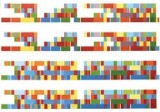That question came up at work on Friday. My boss noted, that his PH101 class was taught by a really hot grad student. His answer? "Because you're not naked."
How do you know you've learned something useful? Mostly, because it becomes "predictive" - at least for awhile. Of course, this is the piece of the puzzle that gets ignored by many of the most passionate analysts: the truth changes over time.
The passionate number crunchers are looking for that ONE magic formula that can predict the future. But, as sci-fi often tries to tell us -- if you "know" the future, you CAN change it. It's the past that you're hosed on. SABRmetrics and baseball blogs in general would take a giant leap forward, if the delivery protocols would simply add "yet", "today" or "perhaps" to every declaritive. But, that might not increase the fun of the discussions.
Doc is dead-on, that the search for knowledge requires care in figuring out what to pay attention to AND what to ignore. But, these answers aren't static. Since 1920 K-rates have gone from 4-per-9 to 7-per-9. Did pitchers get better? Perhaps. Or, did hitters make a CHOICE that hitting HRs was far more important than striking out - so the mass philosophy when heading into the batters box changed? I'd argue the 2nd is probably the larger portion of a mix that could just as easily be 50/50.
Ultimately, what makes Doc one of the best is that he's superb at not only stating his opinion, but then stating in easy-to-understand (and often entertaining to read) prose WHY he believes what he does.

=== Bryned or Rewarded? ===
In the Byrnes POTD, for example... everybody knows what Byrnes' numbers have been. He was an All-Star in '07 and he was injured the last two years. We could noodle around all day discussing his RAR in past years, and come up with the same thing everybody else does.
The question is what Byrnes will be in 2010...
The answer being, a very good 3-position platoon OF with a 30% chance of rebounding to his 2003-04 vintage. As far as we can tell, anyway.
The important thing about Byrnes is that he has SLG'd .500 against LHP's since he fell out of a crib. He does this while playing center field.
The secondary question is what his chance is of recapturing the 20-30 runs above RLP with Oakland, or the 40 he had in 2007...
The essential information here includes the knowledge of whether Byrnes trained clean or not, and what Byrnes' historical comps did at age 34.
It may look like philosophy instead of numbers; in reality, it's the attempt to edit noise and identify the numbers that matter.
.
=== Judicious-Lee Used in 2010?, dept. ===
What do you know about Cliff Lee? Run fifty stats and :shrug: they'll tell you that Lee was great in 2008-09. What then? Are we going to discuss whether Cliff Lee is worth $22m vs $26m? What happens after we decide that?
But, find a pertinent set of comps for Cliff Lee, run their numbers, as below...
...and you might extract some essential information.
In our view, the important stats are the IP columns after the peak years for Lee's comps. Picture-Perfect Lefties get overused, burnt out, and injured because they look so smooth even as they're about to implode.
.
=== 3-D Information Processing dept. ===
Templates and pattern recognition aren't really within the domain of philosophy. They're devices used to organize information and statistics so that you deal with fewer, but more important, bits of information.
The goal isn't philosophy over stats; the goal is logic and pattern recognition to weed stats and find the right ones.
Good ole baseball scouts have been using them for 100 years. Ken Griffey Jr. came up as the lefthand Willie Mays. The differences and similarities between the two became, in 1989-1992, the topic of discussion and a good way to predict Junior's career arc.
.....
All information is good, including runs, RBI, and ERA. Once you have the 5-finger exercises like RAR and FIP down ... can you use them to arrive at the conclusion that reliever Brandon League is a more valuable commodity than starter Brandon Morrow ? :- )
It's not a question of philosophy-over-stats; it's a 3-dimensional approach to the statistical problem that, in an ideal world, transcends a 2-dimensional $/WAR approach.
.
=== Objection, Your Honor dept. ===
How do you know you've found the essential information? Who's to say that Aardsma's FB% caused his lower BB rate and that he can't get away with that much longer?
You don't know you've found the essential information. It's a baseball chat, not NORAD.
The best you can hope for is to propose what might be the essential information, and then let your brainy audience decide for themselves its merit.
Fortunately for us, we're shadow boxing. Glad we don't face Zduriencik's consequences if he picks the wrong information :- )
Cheers,
Dr D
Comments
And back atcha with the kudos San-Man. The Seattle blog-o-sphere, especially MC and DOV IMHO, is a think tank -- ideas shared and refined, as opposed to perpetuated. Any number of guys could take the mike (run a blog) and you'd have a similar result.
For that reason, it would be great to sit in on the chalk talks that Zduriencik's crew have. They evidently take the think tank about three levels farther.